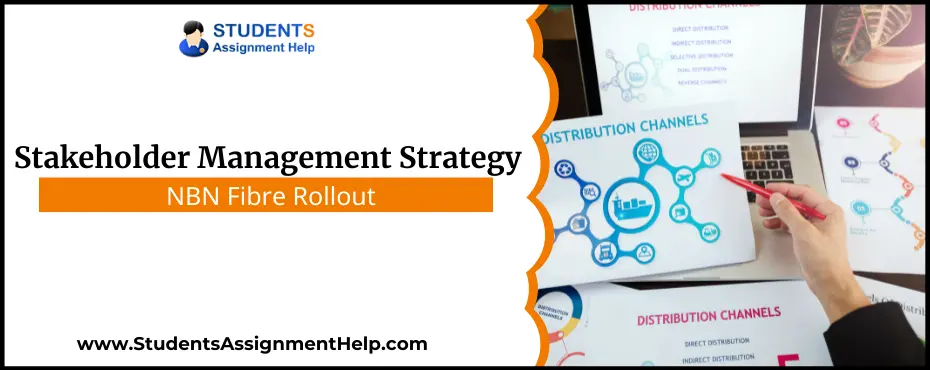Stakeholder Management Strategy: NBN Fibre Rollout

Question: Stakeholder Management Strategy
As a group of experts in IT Stakeholder Engagement you have been hired by NBN Co. to devise a stakeholder engagement strategy for the rollout of the new fibre network rollout within the small town of Whyalla (South Australia).This fibre rollout project within the town will allow high speed internet connections for home users (as part of the NBN – National Broadband Network) but will also benefit the local community (e.g. businesses, the hospital etc.) in many ways.
In this formal strategy paper you are expected to review and understand potential stakeholders, benefits (both direct and indirect), consequences and actions required to implement this stakeholder engagement strategy for the project within Whyalla. Your strategy paper should detail a number of the topics (including models) that have been discussed within this course. You must provide supporting reference to ascertions made within this strategy paper. As this is a professional business paper (directed to the CEO of NBN Co.), your paper should include:
a.) A title page
b.) A table of contents
c.) An executive summary
d.) An introduction
e.) A main section discussing the strategies you are identifying
f.) A conclusion including recommendations and action schedule / plan.
g.) Reference list
h.) Any further attachments / appendices as required
Assignment Solution
Executive Summary
Stakeholder engagement is one of the important factors for a good CSR (Corporate Social Responsibility) strategy. It acts, as the cutting edge for companies as activities, such as identifying and subsequently holding discussions with diverse groups of stakeholders that is essential for the company management. As NBN is rolling out a new fibre network for the small city Whyalla located in South Australia, it is important to understand all key stakeholders of the project and methods of engaging them in an effective manner. Models and their applications to the project are discussed along-with identification of course of action. Engaging every stakeholder group with appropriate form of communication and addressing their needs and expectations will make the project successful.
Introduction
In general, companies feel increasing pressure for recognizing and engaging the stakeholders of the company. However, before understanding the stakeholder engagement strategy, companies need to understand various stakeholders, reasons for engagement, and the intent to use stakeholder management strategy (Widdows and Mullen 2009). Influencers from the civil society, government, and the private sector play a crucial role in creation and maintaining the business value. As the influence goes on the tangent of evolution, companies are required to take a strategic and structured approach for stakeholder relations. Stakeholder engagement holds relevance for every kind of organization. With the help of proper stakeholder engagement strategy, an organization can become serious about its corporate social responsibility too (Busco, Frigo, Riccaboni and Quattrone 2013).
Strategies for stakeholder engagement
Stakeholder engagement strategy is different from the strategy of stakeholder management. Engagement of stakeholders implies the creation of willingness to listen, discussion of issues of interest to stakeholders of the concerned project. The organization has to make sure that it remains prepared for changes according to what it aims to attain and how it operates as an outcome of the stakeholder engagement (Busco et al 2013). Potential stakeholders for the rollout of fibre network in Whyalla are as follows: telecommunication operators, end users, other government agencies, local authorities, and equipment vendors (NBN Co rewrites rollout map – will you miss out on fibre 2013).
Benefits of stakeholder engagement strategy
Stakeholder engagement model given by Jonker and Witte (2006) focuses on participation of stakeholders in the project (Jonker and Witte 2006). Various benefits of stakeholder engagement strategy exist for the fibre rollout project in Whyalla. Consultation with all the potential stakeholders is essential. It will make the critical information available on issues, such as requirements for the access to broadband, willingness of consumers to pay for offered services, interest of operators in participating in the NBN project, likely level of demand, most appropriate and suitable technologies available for the fibre rollout, and availability of investment models.
The consultation with stakeholders can also enable NBN to consider other projects that it will require while working as the managing authority to initiate for the stimulation of demand for the broadband access. It will also help in discussion of challenges in deployment of broadband infrastructure to a small town i.e. Whyalla. Introduction of a fibre rollout plan without proper consultation with stakeholders can lead to the consequence of lack of participation from operators, the use and application of an unsuitable mix of technologies, and limited take-up and usage by the intended end users.
Implementation of the strategy
Seven stages exist for the strategy of stakeholder engagement as shown in the following figure:
Stakeholder engagement model for Stakeholder Management Strategy (Source: Stakeholder Engagement: A Road Map to Meaningful Engagement 2009)
They Are Discussed As Follows:
Stage 1:- Plan-
It includes identification of basic objectives of the project, issues to address, and the stakeholders critical to the project (Stakeholder Engagement: A Road Map to Meaningful Engagement 2009). The basic objective of the project is to establish the network of fibre over the town of Whyalla for the benefit of not only home users, but other communities, such as hospitals and businesses too. Stakeholders critical to the project are end users, other government agencies, telecommunication operators, local authorities and equipment vendors.
The assessment of key internal and external stakeholders will be carried out for identifying the issue of complexity and time required for the completion of the task. Adoption of an optimised multi- technology approach for balancing the fast deployment of high-speed broadband with better economics is needed. For this, consultation with the government and service providers is required (Carroll and Buchholtz 2014).
Stage 2:- Understanding of stakeholders
It includes identification of the urgency to feel for the issues, the legitimacy of the stakeholders’ interest, and the power stakeholders to influence the project. Understanding wants and needs of stakeholders, and the correlation with the wants and needs of the project is essential. The need of every crucial stakeholder group is identified in the stage (Stakeholder Engagement: A Road Map to Meaningful Engagement 2009). The need and expectations of local authorities is to know the areas to be covered under the rollout and regular notifications on the project.
The community including end users, businesses and hospitals need to know the benefits associated with the fibre rollout and how they can use the service. Service providers need to know about potential regulatory changes in respect to any variations to the rollout, improvements in IT and network operations. Equipment vendors should be upgraded about the operating manual and deployment process with clear rules for design and specifications (Great Britain:Parliament: House of Commons: Trade and Industry Committee 2005).
Stage 3:- Internal preparation for engagement
It involves dedication of appropriate time and resources for identification of possible commonalities between the organization and the associated stakeholders. Getting best possible ways into conversations and win-win situations is required in this stage. Possible ways of conversation are as follows: dialogue either in-group or one-to- one (local authorities and service providers); public hearing (end-users); community advisory panel (user group representatives from hospitals and businesses); and focus group (equipment vendors and telecommunication authorities) (Widdows and Mullen 2009).
Stage 4:- Building trust
Different types of stakeholders come with different levels of trust as well as willingness to trust. Recognizing this factor, interaction with stakeholders should be adapted to the level of trust present as well as level of trust needed. For example, if local telecom operators need their queries to be answered in more detail, separate meetings shall be organized for them (Strategic review 2013).
Stage 5:- Consultation:
The stage needs the fair representation of all stakeholders and responsibility for providing proposals and information that can directly respond to the expectations and interest that are previously identified. Provision of complete background information that stakeholders need to have for drawing fair and reasonable conclusions is also needed (Stakeholder Engagement: A Road Map to Meaningful Engagement 2009). For the fibre rollout project, NBN needs to engage stakeholders in the context of potential regulatory changes (NBN Co rewrites rollout map – will you miss out on fibre 2013).
Stage 6:- Response and implementation
It includes understanding of possible course of actions for every issue that is agreed upon. Managing stakeholders across the work-fronts are needed for ensuring internal alignment of the work with the project objectives. Course of action is presented below: Stakeholder engagement prior to rollout: It will include stakeholder relations executives for every site of fibre rollout in Whyalla. It will be followed by stakeholder briefings and community information sessions. Local advertising will be done to let communities, such as businesses and hospitals, and home users to be engaged in the project.
With the help of information displays, brochures and fact sheets, there will be high level of awareness raised among key stakeholder groups (Morris 2012). Stakeholder engagement at the time of rollout: It will include advertisements that will be placed in local newspapers of South Australia. Community bulletins will be released. Flyers will be left behind when the work would reach the stage of semi-completion, which will outline timeframes in which contractors will get back to the work (Morris 2012). Community engagement after completion: Thank you cards and notifications will be left upon the completion of the project (Jonker and Witte 2006).
Stage 7:- Monitoring, evaluation and documentation: Stakeholder Management Strategy
It involves the application of knowledge management for capturing the information and sharing it with the stakeholders and internal management about whatever is learnt. Transparency is required to be ensured by proper documentation of the overall process, especially if the report of stakeholder engagement is required to be submitted to an external audit agency. Reporting to stakeholders is also required in terms of informing them about the progress of the project.
Service Class Status includes categories such as currently active premises, deactivated premises, fibre past the premises. Due to the presence of several subcategories within each of the Service Classes that exist, NBN Co should include all the details related to the subcategory in the external reporting, which can also include estimated time to connection. Such progress reports will improve the understanding of stakeholders to a significant level (Strategic review 2013). They will be engaged in terms of time-to- time updating of network roll-out status (Funding universal broadband 2013).
Conclusion
Stakeholder engagement is an important aspect of any corporate social responsibility approach of an organization. It is essential to ensure that diverse stakeholder groups and their needs are taken into account in an effective manner. The stakeholder engagement model can be applied to develop the stakeholder engagement strategy. With the help of the above-mentioned activities and course of action, NBN Co can engage the relevant stakeholders for the fibre rollout project in the town.
References
Busco, C., Frigo, M.L., Riccaboni, A. and Quattrone, P. 2013. Integrated Reporting: Concepts and Cases that Redefine Corporate Accountability. London: Springer Science & Business Media.
Carroll, A. and Buchholtz, A. 2014. Business and Society: Ethics, Sustainability, and Stakeholder Management. Mason: Cengage Learning.
Funding universal broadband. 2013. [Online]. Available at: https://itunews.itu.int/en/3415- Funding-universal- broadband.note.aspx [Accessed on: 06 October 2014].
Great Britain: Parliament: House of Commons: Trade and Industry Committee. 2005. Ofcom’s Strategic Review of Telecommunications: Thirteenth Report of Session 2004-05. UK: The Stationery Office.
Jonker, J. and Witte, M.D. 2006. Management Models for Corporate Social Responsibility. London: Springer Science & Business Media.
Morris, J. 2012. Back to Basics: How to Make Stakeholder Engagement Meaningful for Your Company. [Online]. Available at: https://www.bsr.org/reports/BSR_Five- Step_Guide_to_Stakeholder_Engagement. pdf [Accessed on: 06 October 2014].
NBN Co rewrites rollout map – will you miss out on fibre. 2013. [Online]. Available at: https://www.whyallanewsonline.com.au/story/1875289/nbn-co- rewrites-rollout- map-will- you-miss- out-on- fibre/ [Accessed on: 06 October 2014].
Stakeholder Engagement: A Road Map to Meaningful Engagement. 2009. [Online]. Available at: https://www.som.cranfield.ac.uk/som/dinamic-content/media/CR%20Stakeholder.pdf [Accessed on: 06 October 2014].
Strategic review. 2013. [Online]. Available at: https://www.nbnco.com.au/content/dam/nbnco/documents/NBN-Co- Strategic-Review- Report.pdf [Accessed on: 06 October 2014].
Widdows, H. and Mullen, C. 2009. The Governance of Genetic Information: Who Decides?. Cambridge: Cambridge University Press.






